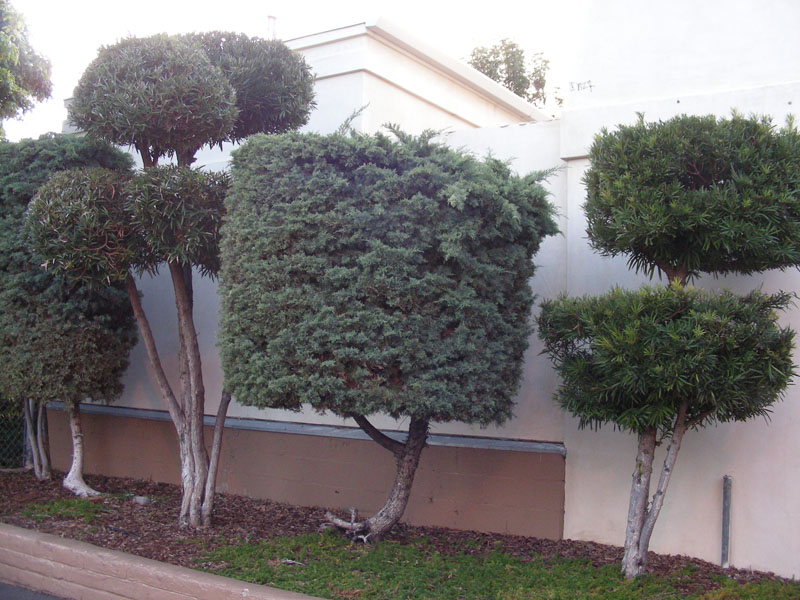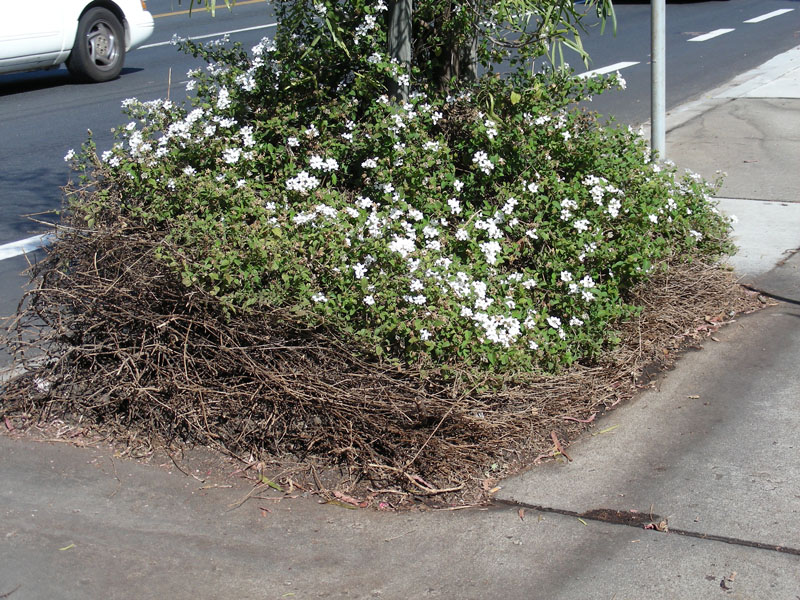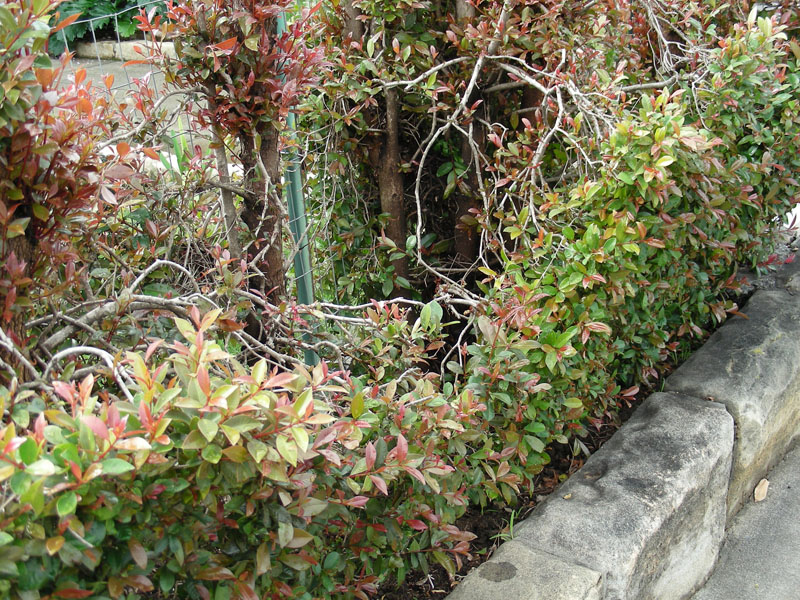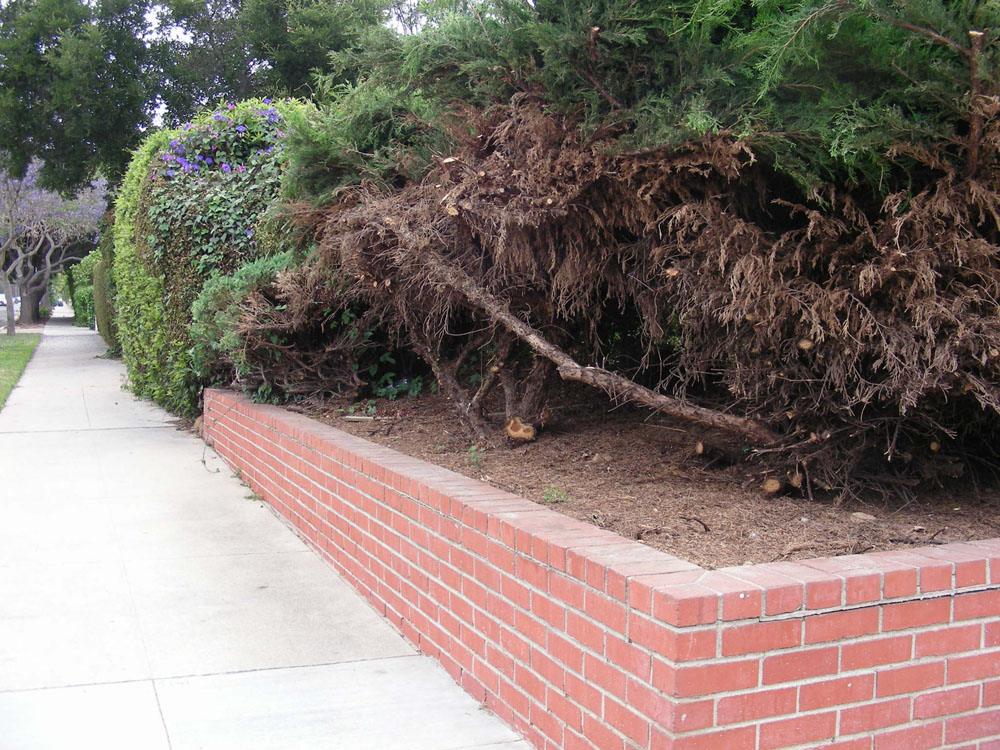
Photo/Illustration: Billy Goodnick

Photo/Illustration: Billy Goodnick

Photo/Illustration: Billy Goodnick

Photo/Illustration: Billy Goodnick


Photo/Illustration: Billy Goodnick

Photo/Illustration: Billy Goodnick

Photo/Illustration: Billy Goodnick

Photo/Illustration: Billy Goodnick

Photo/Illustration: Billy Goodnick


Photo/Illustration: Billy Goodnick
“Then why the heck don’t you just rip out all your plants and put in big blocks of green Styrofoam?! And how about I take that 900 horse-power, fume-belching hedge trimmer and give you a custom manicure?”
Pretty macho, huh? Of course, that diatribe has only played inside my head. My mom raised me to be polite. Besides, I don’t like risking my life when confronting plant janitors holding sharp power tools. I am usually content to rant within my moving car, windows rolled up.
 |
| This is growing next to a church in downtown Santa Barbara. I’m pretty much speechless. Does anyone find this attractive? |
But stop and think about it. Why do so many people go to the trouble of lovingly designing and then installing a landscape only to let it degrade into a mindless construct of bizarre geometric shapes? Here, a cube sheared so severely that there are more brown stubs than leaves. There, a Close Encounters of the Third Kind-inspired floating green disc, perched delicately on spindly gray legs.
Really, wouldn’t it be a lot simpler and more sustainable to rip out the plants and take the Styrofoam challenge? It’s a win-win-win. Your yard would still qualify for recognition by the Mindless Geometric Shape Preserve, you wouldn’t have to spend time or money in a never-ending battle to make the plants do what you tell them to do, and you’d save a lot of money on water, fertilizer, and bug spray.
Maybe I’m missing something and you can straighten me out. I’ve been under the impression that people put plants in their yards because they want to bring a little bit of nature into their lives.
I’ve seen nature. There’s some just outside of Santa Barbara and it’s really cool. There are graceful sycamore trees arching over creeks, centuries-old oaks twisted by the elements, masses of befruited elderberry, and mounds of pungent Cleveland sage. I have not, however, seen any flat planes, pointy pyramids, or cute little globes.
I’m not saying that there isn’t a place in the world for formally pruned hedges or tightly clipped boxwood parterres. My designs tend more toward naturalistic uses of plants, but I’ve done my share of formal schemes when a client’s taste or the style of the home dictates.
 |
| Forget about the sustainability issues—consider the creaion of green waste and the fossil fuels and air pollution that are part and parcel of the professional’s arsenal. The visual by-product of all this extra work is just plain fugly. |
What gets my knickers in a twist is the knee-jerk reaction that seems to demand that every plant in the yard receive its due punishment. Just because you or your maintenance person owns a hedge trimmer does not mean that every plant has to be transmorgrified in the image of a Dr. Seuss illustration.
I have a simple solution: Right Plant / Right Place. If you have a four foot wide space under a window that starts four feet above the ground, select a plant that doesn’t get bigger than four feet wide and four feet high. I’ll wait while you smack yourself on the forehead as this epiphany settles in.
And if you do have ambitious plants that are genetically programmed to burst their boundaries, selectively and artistically shape them with a good pair of hand-pruners (not hedge shears–that’s where flat planes come from) to preserve their natural character.
Here’s my rogue’s gallery of offenders. You might want to have the children leave the room now—this could be traumatic. And if you hear muffled screams coming from a moving vehicle, it’s just me melting down.

A eugenia hedge (Syzigium paniculatum) was been “restructured” to conform to
front yard zoning codes. Let alone, eugenia becomes a 60 ft. tall tree.

Yew pine (Podocarpus gracilior) will grow to 80′ high and 60′ wide. Here’s an attempt
to keep it three feet wide.

Lantana montevidensis makes a beautiful carpet, given adequate space. Here’s what
it looks like ten minutes after the gardener leaves. How many times will this be repeated?

But the big winner is this lovely juniper. Why is someone willing to leave this plant
in their front yard for all the world to see?
Fine Gardening Recommended Products

A.M. Leonard Deluxe Soil Knife & Leather Sheath Combo
Fine Gardening receives a commission for items purchased through links on this site, including Amazon Associates and other affiliate advertising programs.


















Comments
Bra-VO Billy, thank you for simultaneously addressing the issues of poor design, unfortunate plant choices and decidedly un-sustainable maintenance practices. I agree that a beautifully shaped hedge in the right place is just fine...but I'd rather see a soft hedgerow of compatible shrubs gently growing into maturity together than anything so tightly clipped that I can't identify its genus OR species...rock on.
We have our fair share in South Africa of compulsive crazy clippers - but Santa Barbara seems to take the cake - You should start an awards ceremony for heretical hedgetrimming or lamentable landscape decisions... or maybe for awful alliteration - while I'm at it!
I certainly agree that poorly executed pruning, as illustrated in your hilarious (and painful) photos, is inexcusable. I also agree that sometimes people have simply chosen the wrong plant for the space and need to face up to it.
BUT I'd be the last person to squelch the gardener's creative impulse, however it expresses itself. Think of Leven's Hall in the UK! Think of the wonderfully undulating yew hedge at Powys Castle in Wales. Think of of Versailles! As for onesey-twosey plant pruning à la Dr. Seuss, well, I kinda like it. It has become part of the landscape vernacular in San Francisco, near where I live, and I enjoy the whimsicality of it.
I hear you Billy Boy!
Sometimes I think that "plant janitors" assault natural plant forms in order to "have something to do" every week when they visit the site.
Case in point- when I vacationed in Hawaii, I admired a garden area near my hotel room.
Nothing wrong with it, needed a little weeding and mulching. A few straggling vines needed to be clipped back.
When I returned from lunch, the "chain gang" was finishing up on their "globe shaping" of an amazing bougainvillea! I was shocked! Why did they even think that the boug needed to be touched?
I really do believe that some of these maintenance crews do not understand plant form, design or what constitutes true maintenance. They have to accept the fact that some weeks when they visit, there will be nothing needed to be done, accept maybe step back and admire the beauty of a garden!
Shirley Bovshow
Hey Billy,
Dare I ask you opinion on this?
http://gardensgardens.wordpress.com/2009/03/22/a-visit-to-pearl-fryers-garden/
H.
Roots are a problem down here. Some landscapers forget/don't know/never learned that roots will dig up everything. Dried up planters don't look so hot either. Or they become trash cans. Some kids these days think that mall flower containers are a place for soda cans and gum wrappers. The smokers use them for ashtrays. It's disgusting and i know there is a better fix if a good designer came in and thought about it for a couple of nanoseconds.
You could still have a planter but make it so tall that only 10 foot tall giants can reach them. Using the wrong plants is worse than having none at all.
What a mess!! Obviously more focused on praying than gardening. Billy, with all your spare time maybe some volunteer work is in order here.
Garden Lust Journal
I like topiary that is properly done. The key, here, is PROPERLY. There are some plants, like boxwood, that naturally lend themselves to being shaped. Many others, however, end up looking like the sad examples in your photographs. I'd love to make a proper knot garden myself, someday.
While I agree with your esthetic I am troubled by the tone of your column. It is mocking and insulting and hurtful -- and ultimately useless. And it's certainly not the best way to persuade someone to improve. I'm sure I've made some mistakes in my career as a landscape designer -- in fact I know I have. But your way of communicating those mistakes is unpleasant. You could have shown the plants in their natural form in a more naturalistic setting. Or recommended a book on pruning. Or suggested alternate plants that would give a similar effect without outgrowing their spaces. Any of those things would have been useful to the unfortunate people you insulted.
I happen to be passionate about good pruning and extremely good at it. I've been called on jobs where there were shrubs that had been chain-sawed into submission as these were. And instead of insulting the owners or their 'gardeners' I taught them what they did not know; showed them the naked interiors of their rectilinear shrubs. And they now have more beautiful gardens and better informed gardeners.
I am so grateful for your forthright-ness and honesty. I don't find you cynical at all but a defender of the helpless plants. I have this problem with the new home I bought this spring-- those round balls of varying diameters in front of my house. I think it is some sort of box bush, but the previous owners tried the same sculpting methods with leland cypress in the back and I don't even like to think about what they did to the crepe myrtles. They are naked gray stems about 4 feet hich with an explosion of foliage sticking out on top of that. I don't want to cut it all down or dig it all out but I also don't want to subject the plants to this tortuous conformity or myself to the enslavement of having to prune every week!! Oh, and I also have about a 20-foot rectangular holly hedge in the back yard which I could allow to grow on its own as there are no windows or structures nearcy.
Scary! The photos gave me the creeps!
The over use of clippers is not restricted to Santa Barbara. It has spread to the east coast. People addicted to clipping work on the hapless azaleas. Azaleas, if left to their own devices will grow in a beautiful layering pattern. There are folks who just can't allow them to do that. They prune them into giant beach balls, rubix cubes of various sizes and my personal favorite the inverted styrofoam cup.Travel east and bring your camera.
I'm with you. The worst offenders in my neighborhood are the folks who have their forsythias pruned into balls or flatopped. They have such a lovely habit, why would anyone do that?!
I agree and disagree. While some people prune plants that look best unprunned, there is something to be said about being able to make a columnar plant into a spiral, trimming boxwood hedges or cypress into arches or hedges, or just topiary in general. Everything is best in moderation though :) Yes, a little harsh of a column..Not everyone shares our love for gardening or maybe its an 80 year old widow with no means to pull out that horrific yew!
I agree and disagree. While some people prune plants that look best unprunned, there is something to be said about being able to make a columnar plant into a spiral, trimming boxwood hedges or cypress into arches or hedges, or just topiary in general. Everything is best in moderation though :) Yes, a little harsh of a column..Not everyone shares our love for gardening or maybe its an 80 year old widow with no means to pull out that horrific yew!
I agree and disagree. While some people prune plants that look best unprunned, there is something to be said about being able to make a columnar plant into a spiral, trimming boxwood hedges or cypress into arches or hedges, or just topiary in general. Everything is best in moderation though :) Yes, a little harsh of a column..Not everyone shares our love for gardening or maybe its an 80 year old widow with no means to pull out that horrific yew!
What's irking you, simply delights me. When I drive past a house with a Lego garden, I glow with a smile of condescending satisfaction on my punim. "People do the darndest things!" There's really not enough pure silliness in the world and we have to take it where we can find it.
And by the way. Your mother didn't only raise you to be polite. She raised you to wire plastic flowers to plants so they'd alway look pretty. Exquisitely silly and delightful.
What I find really funny are the people that clip thier forsythia, quince, or whatever into oblivion and then wonder why it won't bloom...
I was talking to a coworker the other day about a similar topic. I was pruning some burning bushes with hand pruners. I mentioned the chainsaw was possibly one of the worst inventions for tree work. The chainsaw enabled anyone who thought they could make money in tree work to butcher trees. Whereas before the chainsaw the only people involved in ornamental tree work were people who enjoyed the trade. I don't recall any pictures of the Founding Fathers of standing in front of topped trees. But to be against technological advancements seems almost un-American and to be against competition between companies in the tree industry that sometimes seems to hurt quality seems uncapitalistic. I think the blame cannot rest on the technology or the system of economics influencing an industry or trade, but rather I think the blame has to rest on the good practitioners of a trade by not educating the public or not reaching out to those struggling economically to educate individuals in the proper practice of a trade. The good practitioners, like myself, are to blame by not changing the status quo through the practice of our everyday life.
I have a garden where most of my plants,bushes, etc. go a bit crazy, a bit wild. I do prune when necessary, not a lot, but just enough to keep the garden "clean". I do agree with Billy in most of the "technical part" of what he argues but there is no need to be insulting. Maybe the person who did this job doesn´t have the slightest idea of what he/she was doing. It is clear that this person is a bad clipper, and tried to achieve some ornamental style with very bad results. The word is teaching, educating and not mocking. This could be a nice person who lacks the knowledge or some common sense to stop when needed. I think all of us, plant lovers, have made one or two mistakes in our garden. We all have to be humble and learn how to teach and share our knowledge without sounding arrogant and disrespectful.
Rapier wit to the rescue! Right on, Billy! Thanks for throwing some harsh light on a problem which seems to be nationwide. We need more Green Gardener programs to wake up the guys with the power tools. We can't just plant a site and walk away. We need to educate the workforce.
This topic would make a great article, with before and after photos, discussion of crown reduction, what tools to use for what and when. Formative pruning versus productive pruning would also be helpful. I know there is an entire DVD on this topic, but a concise, easy to understand and accessible article or two is always useful. And on a regular basis, maybe once a year. I find that hedge shears are best used for deadheading masses of Dianthus. After having new shrubs put in ie. Viburnum, Holly, Junipers etc., I found that I should have gently pruned them regularly as they grew to the desired size. Now I find myself having to do more drastic crown reduction or do more cutting to decrease size. I too, raise my hackles when I see endless yards with shrubs pruned into a repetion of green marshmallows. Pruning is an art form and one needs to develop a hand and an eye for it. The trick is to be able to prune and when finished no one can tell that you were there with your tools of destruction.
Agree and disagree- worked at my own landscape maintenance/gardening business for 30 years- very challenging to get folks to pay $ for hand pruning when hedge clipping is quicker and therefore less expensive. I carefully educated my customers, and did a mix of both- like the lady who could not understand that lilacs bloom on last years growth, and shearing off all the new growth in September took off all of next year's flower potential. People appreciated knowing "why".
Education is the key, and licensing- anyone with a pickup truck, a lawn mower and a chain saw can call themselves a
"landscaper" or do tree work- often with disasterous results.
Perhaps people working in garden centers could help by educating customers about the plants they are buying.
Here in NY that pruning style is very popular with the Italian contingent. To be generous, it is certainly playful! There is no good excuse for poor plant selection, save ignorance. Most of this stuff should never have been planted in Santa Barbara in the first place. I support the use of native plant materials. I prefer to see geometric forms left to man-made structures, and for plants to express their natural organic forms. It is that very interplay that results in so many truly wonderful landscapes! These photos document some very un-skilled pruning. And that last yew? Even it is not beyond a skillful, redeeming pruning. You might be surprised what you could coax out of it with a little effort. Yes, the results would be very sculptural in quality. These plants, living beings that they are, deserve and need all the love we can give them. Ever notice how trees that are admired tend to thrive, and trees that are loathed tend to suddenly die?
Aesthetics are wide. In Puerto Rico, all these examples
you have brought are the rule. No taste, a total absence
of imagination and intelligence.
That is the result of people in landscaping maintenance or
ignorant property owners thinking that a garden is not
a garden unless you have to prune like a madman.
Hedges, hedges everywhere and mutilated vegetation with ridiculousshapes..unnatural and creating excessive organic waste. Polluting and a waste of energy.
Wow, what a blog! That ornamental shaping of hedges, bushes and trees should be defined as purely a matter of taste. Of which we know is beyond dispute. Different strokes for different folks. As a successful floral designer I wouldn't sell much of anything thing, much less design wedding flowers for the masses if I didn't provide according to the customers taste and vision. It comes from different ethnic backgrounds, cultural influences, personal tastes developed over the years, education and skill levels, supervison/lack of supervision, planning/lack of planning and the bottom line, money/lack of money and or ability. I love the examples of the 80 year old woman, and the "Italian contingent". So truthful and honest.
So is your report Billy, expressed your own way, able to rise up the fans of "insulting", to the fans likening your exposure to an appreciation of the humor and whimsy it might provoke.
Bottom line, in this age of reducing resources we need a plant and tree police dept to supervise, or provide variances, or permits to plant properly those shrubs in plain site. It'll create jobs, teach people, if started at the town level, it'll soon become as common place as a variance/permit needed from your neighbors to build a deck in your back yard. Change the rules locally, and the landscapers will start to notice when they have to pay a fine for installing shrubs and trees that die within a year or two. Sound silly? Complete lunacy? You decide.
Log in or create an account to post a comment.
Sign up Log in